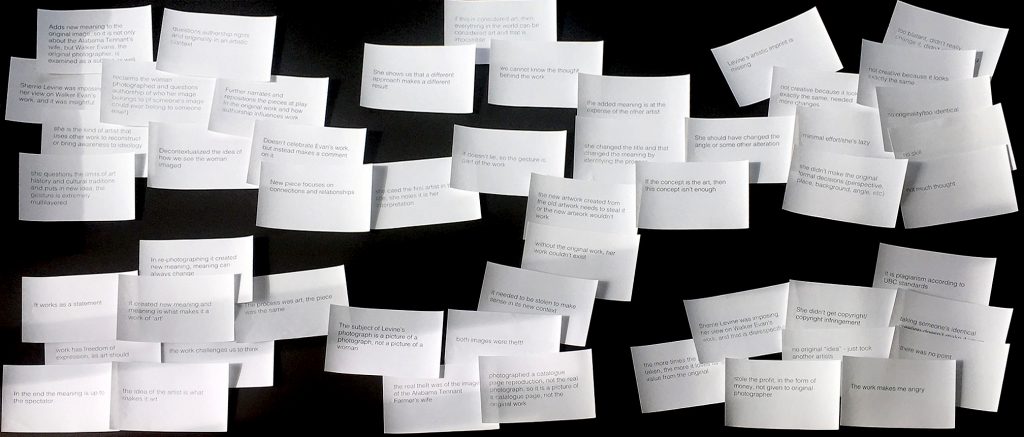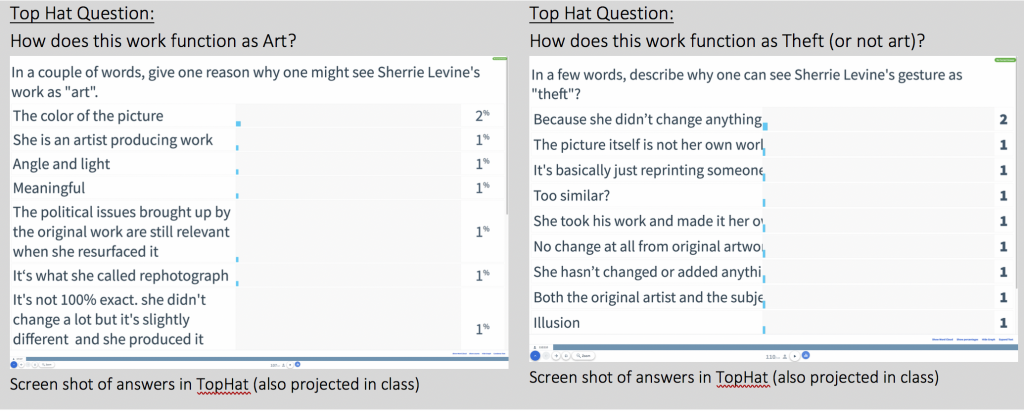March 5-10 “Appropriation”
Lecture
On March 3, Penelope Umbrico will be giving a lecture starting at 5:30pm in the Life Building at UBC, this will replace the lecture
Lab
For this class some might take students out on a class trip to a gallery, or we the “Sherrie Levine” activity. You can also go ahead to Week 9 plans, and use the class time to discuss ideas for the appropriation draft.
Gallery Trips booked this week are:
Monday March 9 (CAP)
-
- 2:45-3:15pm – Audain Gallery, 149 West Hastings – Ale
- 4:45-5:15pm – Audain Gallery, 149 West Hastings – Ale
and
Tuesday March 10
-
- L14 – 11:45-12:15pm – Audain Gallery, 149 West Hastings
- L16 – 1:45-2:15pm – Audain Gallery, 149 West Hastings
SHERRIE LEVINE ACTIVITY
Walker Evans’ work of Allie Mae Burroughs, an Alabama farmer tenants’ wife from 1936, depicts an ambiguous face of how one can depict poverty in the American south during the depression. Levine, hijacks the discussion from how we can subject people to images and ideas, acting as representations, to ideas of authorship and what it means to make an image, representation, thus idea. Appropriation changes the way we dissect the image because we must bring in previous meaning to understand new meaning. I ask students to give a reason why the image could be seen as ‘theft’ as well as come up with a way it could be seen as ‘art’.
Top Hat Screen Shot:
I will select approximately 50 of the most interesting and diverse student answers from the TopHat activity from the previous lecture, and print them out on index cards. The cards are available in the lab classroom, where you can facilitate a debate of the various answers.
Appropriation Workshop Outcomes:
- Enact a critical outlook as visual readers, recognizing how meaning is cultivated and perpetuated through representation.
- Produce ethical, informed, multi-dimensional, work that is situated in contemporary concerns.
- Identify the characteristics of medium towards the interpretation of an image, in order to make informed material choices for their own work.
Debate Map Lesson Plan
(50 minutes)
- Please have students continue from the first appropriation in-lecture activity, continuing the debate of Sherrie Levine’s work. You will be provided with a series of responses on index cards that comprise interesting answers from TopHat by students in the class, (these will be passed on from teacher to teacher as there is only one set!) there will be some empty index cards for students who wish to add more responses to the debate of Sherrie Levine’s Art vs. Theft. Leave the students’ additions in the pack for the next class, and let us see where this goes.
- Have students arrange a “debate map” with the different answers either on the white board (with magnets) or flat on tables lined at the side of the room. Have them order the various answers in a way that makes the divide between “Art” and “Theft” (and everything in-between or even both sides!) towards the creation of a skeleton of reasoning. If they wish to add in more labels, such as “both” or “neither” or anything else that may come up
- On blank index cards, have them fill in areas or add points that would complete the map that seem to be missing, if they haven’t already done so.
- By the end, go over some of the answers which ultimately give evidence of our values and how they reside in art-making. You may want to ask them to place themselves on an area on the map, or to pick up a card that most represents how they feel about the work.
- In particular, in our contemporary day is skill the main indicator of a work of art work or artist? Does an artist sometimes have to take a wrong step (stealing) in the right direction (questioning authorship and expertise/authority) in order to bring out larger issues? How does a retelling or appropriation use the initial agency of the work in its new meaning? (This question is vital as for the most part the appropriation projects become music video’s or trailers and lack any uncovering of how the initial footage projected particular ideologies, and how appropriation can expose these and break them down, rather than perpetuate them). You may also want to question if the theft makes them angry, could that affect not be considered art? If they show that they prefer the answer “there was no point” question if there really wasn’t any idea or if they just didn’t like the idea, or if they are somewhat focused on originality you can question if the gesture of re-authoring the work was not original? Etc
- For further information on a debate maps, visit Derek Bruff’s Agile Learning Blog

Sample of an ordered debate map of the various readings of Sherrie Levine’s work.
Homework Reminders
- The rest of the online Modules are due March 11, end of day.
- Appendix Video “Chronology” is a recommendation, there are no quiz questions as it is optional

